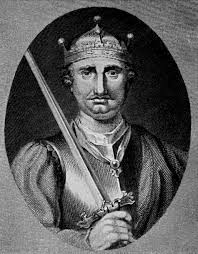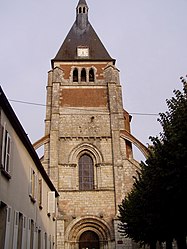In the Middle Ages, beards were mostly worn by old men. Venerable old men were described as having long white beards; in the epic Song of Roland, for example, Charlemagne is described like this. The length of the beard indicated age and wisdom. Hermits also would typically have beards. The image below is of a reliquary at Aachen containing part of Charlemagne's skull; you will notice he is shown with a beard.

But young or middle-aged men did not have beards, nor did monks, those who tried to follow an austere religious life in a group (the monastery) rather than individually as hermits.
This meant that they had to shave. They didn't have modern safety razors, much less Norelco electrics, and certainly no shaving cream in a handy aerosol can. Water or, with luck, soap and water got the beard ready, then a sharp knife was used to cut the bristles, ideally not cutting any skin or blood vessels in the process. One could shave oneself, but in the towns and aristocratic courts one was usually shaved by a barber.
Barbers also functioned as surgeons. They had lots of sharp blades around the place, so they would do any amputations that seemed necessary. They were also skilled in figuring out how to stop bleeding. Alternately, they knew how to cut someone carefully and precisely if they needed to be "bled," getting rid of the bad humors, to allow someone to heal more readily (before you mock bleeding, recall that it continued into the nineteenth century). After a battle, the barber-surgeons went out to check on the wounded and see if they could be saved.
Getting back to beards, the "clean shaven" look was not exactly what we would call clean-shaven. In certain circles today the two-day-growth look has become popular (you can buy trimmers to keep your beard constantly at that length), and medieval men would have fitted right in. No one bothered to shave every day. Young men, however, were normally depicted with smooth cheeks, often rosy. Because they were also depicted with shoulder-length hair, it might at first glance be hard to tell the men from the women in many a medieval illustration--but in fact it's easy, because men wore knee length tunics, women floor-length dresses.
It has been suggested that young men didn't wear beards because they would catch in their helmets. This seems unlikely, because peasants and townsmen too were always depicted as beardless until they became old and venerable. Also, until the late Middle Ages a helmet just covered the crown, back of the head, and top half of the face.
In the monastery, monks not only shaved their beards but also the top of their heads, the so-called tonsure. The effect was something like male pattern baldness, except the rim of hair went across the front of the head too (unless the monk actually had male pattern baldness).
The monks were thus distinguished from the rest of society at a glance if they tried to run away from the monastery.
Monasteries normally shaved everybody, face and head, on Saturday to be ready for Sunday. Saturday was also the time for the weekly bath. They might also be bled at the same time if they were feeling too frisky. The barbers at the monastery had a long and busy day.
© C. Dale Brittain 2021
For more on aspects of life in the Middle Ages, see my ebook, Positively Medieval, available from Amazon and other major ebook platforms. Also available in paperback!







